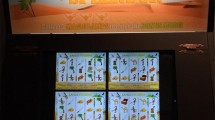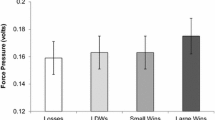Abstract
This experiment used motivational instructions to test whether experienced slot machine players are able to manipulate the frequency of winning outcomes and the time taken to deplete funds while playing a popular slot machine game. Twenty-four participants played in four conditions intended to motivate them to play the game as they normally do, to deplete funds quickly, to get a long losing streak, and to avoid getting a bonus round. Compared to how they normally play, participants significantly reduced the number of bought paylines when trying to get losing streaks or avoid bonus rounds. They also wagered significantly more credits per line when trying to deplete their funds quickly. This experiment shows that experienced slots gamblers have an implicit understanding of reinforcement rate and time on device, and that they are able to manipulate these game outputs at will by adjusting the number of paylines they buy and how many credits they choose to wager. When playing normally, they try to maximize reinforcement rate by purchasing the opportunity to win on many paylines. Player control over reinforcement rate and time on device does not alter payback percentage so there is no monetary advantage to manipulating these game outputs.

Similar content being viewed by others
References
Blaszczynski, A., & Nower, L. (2002). A pathways model of problem and pathological gambling. Addiction, 97, 487–499.
Dixon, M. J., Fugelsang, J. A., MacLaren, V. V., & Harrigan, K. A. (2013). Gamblers can discriminate ‘tight’ from ‘loose’ electronic gambling machines. International Gambling Studies, 13, 98–111.
Dixon, M. J., Harrigan, K. A., Sandhu, R., Collins, K., & Fugelsang, J. A. (2010). Losses disguised as wins in modern multi-line video slot machines. Addiction, 105, 1819–1824.
Dixon, M. R., MacLin, O. H., & Daugherty, D. (2006). An evaluation of response allocations to concurrently available slot machine simulations. Behavior Research Methods, 38, 232–236.
Dowling, N., Smith, D., & Thomas, T. (2005). Electronic gaming machines: are they the ‘crack cocaine’ of gambling? Addiction, 100, 33–45.
Ferris, J., & Wynne, H. J. (2001). The Canadian problem gambling index. Ottawa: Canadian Centre on Substance Abuse.
Goodie, A. S., & Fortune, E. E. (2013). Measuring cognitive distortions in pathological gambling: Review and meta-analyses. Psychology of Addictive Behaviors, 27, 730–743.
Harrigan, K. A., & Dixon, M. (2009). PAR sheets, probabilities, and slot machine play: Implications for problem and non-problem gambling. Journal of Gambling Issues, 23, 81–110.
Harrigan, K., Dixon, M., MacLaren, V., Collins, K., & Fugelsang, J. (2011). The maximum rewards at the minimum price: Reinforcement rates and payback percentages in multi-line slot machines. Journal of Gambling Issues, 26, 11–29.
Harrigan, K., MacLaren, V., Brown, D., Dixon, M. J., Livingstone, C. (2014). Games of chance or masters of illusion: Multiline slots design may promote cognitive distortions. International Gambling Studies. Available online prepublication May 21, 2014 at: http://www.tandfonline.com/doi/full/10.1080/14459795.2014.918163#.U5SfKyipGnk.
Haw, J. (2009). The multiplier potential of slot machines predicts bet size. Analysis of Gambling Behavior, 3, 1–6.
Ladouceur, R., & Walker, M. (1996). A cognitive perspective on gambling. In P. M. Salkovskis (Ed.), Trends in cognitive and behavioural therapies. Hoboken, NJ: Wiley-Blackwell.
Livingstone, C., Woolley, R., Zazryn, T., Bakacs, L., Shami, R. (2008). The relevance and role of gaming machine games and game features on the play of problem gamblers. Adelaide, South Australia: Independent gambling authority of South Australia. Retrieved July 7, 2013, from http://www.iga.sa.gov.au/publications.aspx.
MacLaren, V. V., Harrigan, K. A., & Dixon, M. (2012). Gambling motives and symptoms of problem gambling in frequent slots players. Journal of Gambling Issues, 27, 1–13.
Raylu, N., & Oei, T. P. S. (2004). The gambling related cognitions scale (GRCS): Development, confirmatory factor validation and psychometric properties. Addiction, 99, 757–769.
Stewart, S. H., & Zack, M. (2008). Development and psychometric evaluation of a three-dimensional gambling motives questionnaire. Addiction, 103, 1110–1117.
Stewart, S. H., Zack, M., Collins, P., Klein, R. M., & Fragopoulos, F. (2008). Subtyping pathological gamblers on the basis of affective motivations for gambling: Relations to gambling problems, drinking problems, and affective motivations for drinking. Psychology of Addictive Behaviors, 22, 257–268.
Templeton, J. A., Dixon, M. J., Harrigan, K. A., Fugelsang, J. A. (2014). Upping the reinforcement rate by playing the maximum lines in multi-line slot machine play. Journal of gambling studies. Available online prepublication March 2, 2014 at: http://link.springer.com/article/10.1007/s10899-014-9446-5.
Thomas, A. C., Allen, F. C., & Phillips, J. (2009). Electronic gaming machine gambling: Measuring motivation. Journal of Gambling Studies, 25, 343–355.
Williams, R. J., Volberg, R. A. Stevens, R. M. G. (2012). The Population prevalence of problem gambling: Methodological influences, standardized rates, jurisdictional differences, and worldwide trends. Report prepared for the Ontario problem gambling research centre and the Ontario ministry of health and long term care.
Conflict of interest
None
Author information
Authors and Affiliations
Corresponding author
Appendix
Appendix
Four sets of instructions were used. The instructions for each condition were as follows
Do Your Best
You are an experienced player and you probably know a lot about how to play VLTs and slot machines. I want to see how you use what you know about these games to increase your chances and have fun playing. So I want to see you playing at your best like you normally do. This time I will start you out with 5,000 credits and let you play for 15 min or until you get down to below 250 credits. Play the game like you normally would play slots at your favourite casino or VLT lounge. You are not playing for real money so focus on showing how well you normally play. This time you will automatically get 1 ticket for the $500 draw, just for showing how well you normally play the games! Also, there will be 24 people in the experiment and the person who manages to get the most credits at the end of 15 min will get an extra ticket!
Go Broke
An experienced player like you probably knows how to get the most gambling entertainment for your money by playing the games for a long time. This time I want to see what you know about how much control you have over how long you get to play. But rather than try and play for a long time as you probably would do when you are playing for real money, I want to see you play in a way that you think will make it likely that you will lose your credits as fast as possible. This time I will start you out with 5,000 credits and let you play for 15 min or until you get down to below 250 credits. You are not playing for real money so focus on showing what you know about how to control how long you get to play. If you can get your balance down to under 250 credits you will get 1 ticket for the $500 draw! Also, there will be 24 people in the experiment and the person who manages to get their balance down to below 250 in the fewest number of spins will get an extra ticket!
Losing Streak
A losing streak is when you are playing a VLT or slot machine and you have a series of spins where you play and play but you just can’t seem to win anything at all. An experienced player like you probably tries to avoid losing streaks when you are playing for real money. This time I want to see what you know about how much control you have over losing streaks. But rather than try and avoid a losing streak, I want to see you play in a way that you think will make it likely that you will lose a lot of money in the worst losing streak possible. This time I will start you out with 5,000 credits and let you play for 15 min or until you get down to below 250 credits. You are not playing for real money so focus on showing what you know about how to control losing streaks. If you win nothing for 12 spins in a row, you will get 1 ticket for the $500 draw! Also, there will be 24 people in the experiment and the person who manages to lose the most credits in a losing streak will get an extra ticket!
Bad Bonus
One of the best things that can happen when you are playing a slot machine or VLT is when you get a bonus round. An experienced player like you probably knows how to try and get the machine to give you a bonus round. This time I want to see what you know about how much control you have over bonus rounds. But rather than try and win a lot by getting in a bonus round, I want to see you play in a way that you think makes it less likely that you will get a bonus round. And if you do get into a bonus round, I want you to try win the least amount that you can. This time I will start you out with 5,000 credits and let you play for 15 min or until you get down to below 250 credits. You are not playing for real money so focus on showing what you know about how to control bonus rounds. If you don’t get a bonus round within 15 min you will get 1 ticket for the $500 draw! Also, there will be 24 people in the experiment and among the people who do get a bonus round, the person who manages to get the smallest bonus will get an extra ticket!
Rights and permissions
About this article
Cite this article
MacLaren, V.V. Experienced EGM Players Know How to Control the Reinforcement Rate and Time on Device. J Gambl Stud 31, 1789–1798 (2015). https://doi.org/10.1007/s10899-014-9498-6
Published:
Issue Date:
DOI: https://doi.org/10.1007/s10899-014-9498-6




